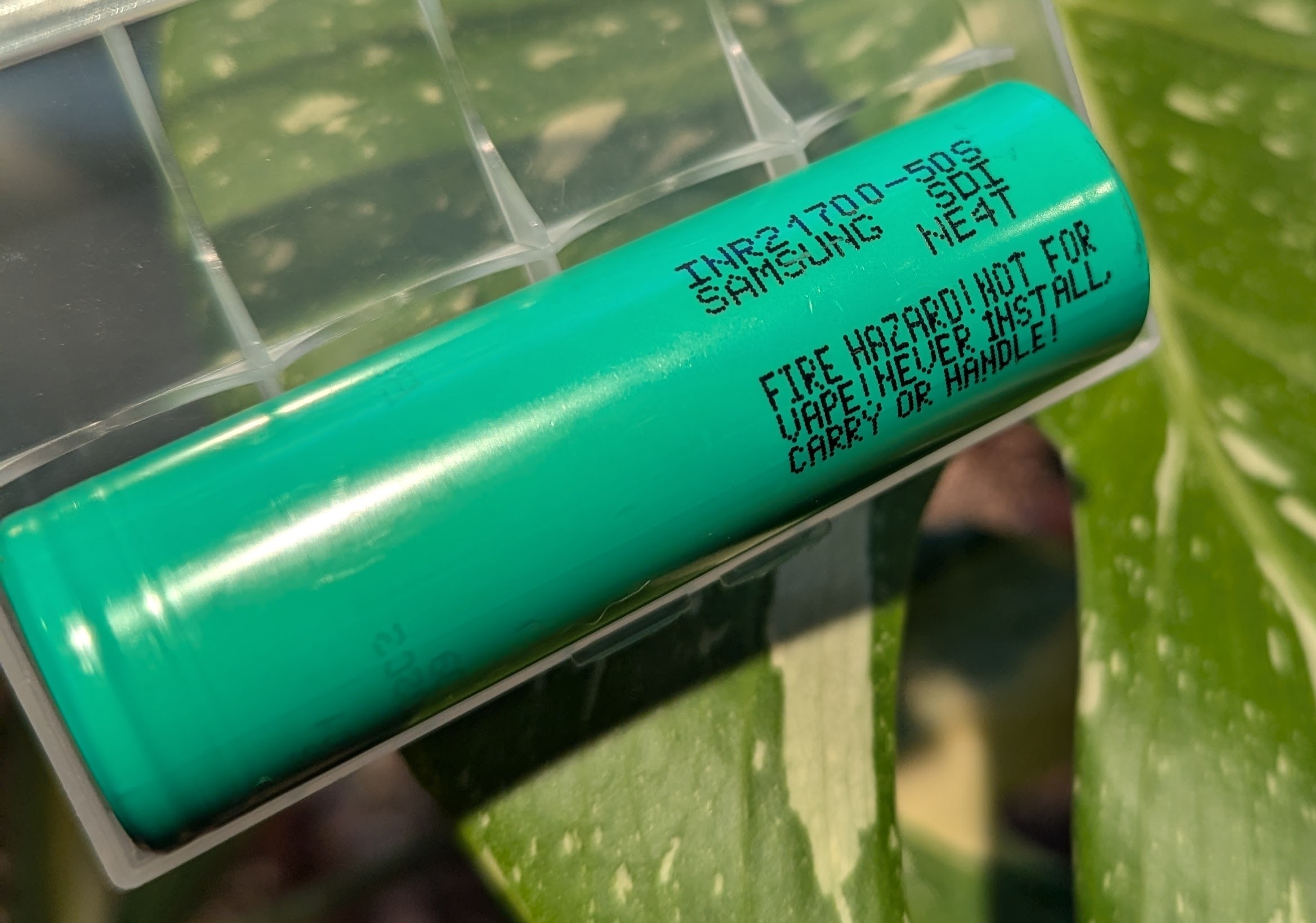600 miles? Call me when they make one small enough to fit in a car
heyooooo
You joke but I literally pictured a super long battery for a solid bit before it clicked. I was thinking maybe it was coiled and technically really long like a spool of wire
Technically …… assuming cylindrical, it’s a long strip of metal rolled up. Not that long though
It’s such a dumb metric for batteries. I wish people would stop using it.
Eh, it’s really not that dumb assuming there’s an average electric discharge for electric vehicles. Most laypeople don’t understand kWh beyond “bigger number better”.
I mean its a more a metric for the over vehicle. It can move its self that distance on a charge.
The battery would kWh but that alone is insufficient for evaluating the vehicle
kWh/Kg is really all that matters, maybe max charge/discharge rates too.
But they aren’t clickbatey enough for commercial news.
But kWh/kg doesn’t account for additional energy sinks or drive train efficiency
Sure, for a specific car, but Samsung isn’t making cars, just a battery that could go in a number of different vehicles. So all we’re really able to compare is batteries, not full vehicle efficiency.
If they’re intending to suggest this new battery, when fitted in an existing EV (say a Model Y) would result in a 600 mile range, then it’s interesting, but all other things (drivetrain, drag, vehicle weight) would have to remain constant.
Oh dang I’m the fool. You’re 100% correct. I assumed it was a full vehicle system with a battery.
It’s not stupid if it takes hours instead of minutes to charge up. If this tech really delivers, then I’ll be more than ok with a 200 miles battery that charges in 3 minutes.
Miles
Metric
Pick one 😂
Metric = a measurement, not the metric system.
@programming.dev
Makes sense
It’s what people care about.
An EV that can only travel 300 miles on a charge is a complete nonstarter for me. It’s simply not enough for trips I take with regularity.
But it it’s stupid because it doesn’t really relate to anything. Different cars have different ranges with different sized batteries and different efficiencies, at different weights and different volumes, so I have no idea what it means.
Wouldn’t it be both more straightforward and more meaningful to phrase it like: x% more power for the same weight as current LfPO used in Tesla standard range
Most importantly, batteries will always be expensive, so most manufacturers will prefer fewer/smaller for a cheaper and lighter car of similar range. Aside from trucks, I don’t see why we’d ever see many 600mile range EVs, especially if we get truly fast charging
But people don’t care about that. They care “how far can x car go with it”.
I will never even consider buying an EV that can’t go a minimum of 500 miles on a charge. I’m not willing to have short weekend trips held hostage by the availability of charging stations. 500 miles is still not a long round trip.
But most ICE vehicles won’t go nearly that far on a tank of gas, they seem to most commonly go a bit over 300. Why should EVs be any different? Many of them already claim a similar range.
The difference is the ubiquity of gas stations. That infrastructure was built out over a century, and we need to do similar with chargers but ten times as fast
It’s really weird how emotional some people get about EV range and their completely imagined charging issues. On a 500 mile trip an EV adds maybe 20 minutes of charging, and that’s if you are really trying to maxmin gas stops in an ICE.
Meanwhile never going to the gas station during the week because I charge at home saves way more time.
My car is a hybrid that goes 550 on gas without being plugged in. I’m not willing to go below that.
The ubiquity of gas stations is exactly the point. Less populated areas aren’t going to add charging stations, and even if they did, fast charging still sucks.
As someone who does weekend trips in a 300 mile EV all the time, this is hilarious. You do you though.
How about the 2024 Ford Escape PHEV. 37 mile range on electric, which will cover most of dialy driving, and then it switches to gas. Should work out that you can pay 1/3 cost for fuel most percent of your driving, and not have to worry about long range trips. Base price is like 41k, meaning a used vehicle would drop quick.
Edit: apparently the 2025 now starts at 38k. So price came down didn’t find range.
I really don’t get why PHEV never ramped up to be the next thing instead of all this push to go full electric when the tech and infrastructure isn’t good enough yet.
I have a 150mi EV and a PHEV. I won’t be bothering with another PHEV, unless I need something that can tow long distances. Every long distance trip I’ve taken in our PHEV since ~2020 would have been almost identical to a trip in an EV. Drive about 3 hours, and stop for 20 minutes for food/restroom, and back on the road. Even with our PHEV, which can do over 600mi on a tank, we were naturally stopping at almost the exact same points as I would when I planned out the same route in an EV.
As minimal as it is in a modern car, dealing with the ICE side of it just isn’t worth it in a daily driver from my perspective. I have an old classic that’s ICE, and if I’m going to be doing oil changes and such, I’d much rather do them for fun on that, than be required to on my commuter.
Yeah but PHEVs could be made a lot better. There has not been any push to improve on them, and there’s plenty of room for it.
Toyota had a rad PHEV supercar concept that got 100mpg that never even came close to moving toward production. (As just one example)
I feel like you missed the point. The point is that you probably want to stop every few hours anyway so there’s not a lot of point getting a PHEV. You’re buying two engines for the price of two, with the maintenance costs of a gas engine (higher) and extra weight. It’s just fear that gets people to buy PHEV. There’s hardly any mpg benefit over a gas car in real world usage, and there’s hardly any of the lively acceleration of a proper EV. No fun, no cost savings, just all initial expense. Get an EV or stick with your old gas car, PHEV is absolutely not the best of both.
There has been a problem with owners not charging PHEVs.
But I suspect the main reason is profit margins. Companies learned that selling fewer premium products could be more profitable than selling lots of cheaper models with tighter margins.
So they all basically fucked on out of the cheap car market. Except for Hyundai/Kia, Mitsubishi and Nissan, you can’t really buy an econobox anymore.
PHEVs are like high end econoboxes with an expensive mix of technologies that make margins too thin. Which sucks because I live in a cold climate and have long weekend drives to help family and occasional traveling jobs that make a hybrid the best choice for the time being.
I agree with the first part, but the second is in the past.
I don’t see why hybrids and plug-in hybrids weren’t huge in the past decade or two, but now the technology is here to go full electric and we just need that little push to get legacy manufacturers onboard, to get prices down and charging locations up. iTs no longer a technology problem but a scaling problem
I think the complaint is most people don’t bother using the ‘P’ so it turns into an ICE with extra steps
deleted by creator
I have an older fusion energi and don’t plug it in because charging every day is a hassle.
I’m not anti-anything though. Clean energy is good, efficiency is good, the luggage space wasted isn’t awesome but whatever. I’m just explaining why I care about range. That’s not a long weekend camping trip and the infrastructure for pure battery in the places I like to be don’t make low range viable.
How so, I’m curious? Do you drive into no mans land hundreds of miles away from civilization or are you a robot that never needs to take a break?
That’s a 3 hour drive into the mountains, and running out before I get back. It’s not a long trip.
But, yes, stopping on a road trip is also a massive issue, and turning a 5 minute stop once a day into 20 3 times a day (on the limited routes where there are charging options) on an actual long trip would also be a dealbreaker by itself.
I don’t know how remote your mountains are, here there would likely be a charge point less than 50km away but I don’t know where you drive. I give you that.
Your second point though, you might want to reconsider your driving habits. Random google result for breaks when driving: “If driving long distances, you should stop for at least 15 minutes every two hours. Stop often to rest for at least 45 minutes every 4.5 hours of driving to avoid getting tired and stay alert. Plan to stop for a break every 100 miles on your long road trip so that you can relax. Try to only drive for 9 hours a day.”
If there was a charge point within 50 miles I wouldn’t want to be there.
A five minute stop once for gas is already more than too much of a waste of time. I absolutely will not throw away hours a day for no reason.
Even with a 10-15 mins recharge? A couple of times a year I do make a 500 mile journey and if there wasn’t a sea in the way I would happily do it all in one sitting. But as a teeny tiny compromise I wouldn’t mind stopping to charge once or twice along the way! It would add about 20 mins to the journey sure, but seems like it’s worth the benefits to me.
I don’t think you would get to the charger in 20 minutes. Assume there will be line.
I’d think that too, but I had my first ever ride in a Tesla recently and the way the supercharger network is handled seems pretty clean. Far from a Tesla fan boy but way the car books you a slot and then charges you a fortune if you overstay meant that we had no problem getting a space. Once charging becomes the norm it will be fine.
I don’t go places where recharging is an option.
The long trips are ones where I’d be turning one 5 minute stop into at least an hour of stops per day. That’s not a small compromise any more.
You drive a full day with only one five minute stop? I think taking regular breaks is recommended when driving for long periods.
Absolutely. A stop is lighting time on fire. It turns a tedious experience into a completely unbearable one.
Yet! It will be an option everywhere eventually…
Want a stupid metric? How about miles per gallon
If it were any other company I would be thrilled. With Samsung, this is going to be internet enabled, you’ll need an app to turn your car on and off, and it’ll probably play ads at high volumes constantly while driving.
I know you jest, but Samsung is a massive battery supplier.
These will be plain old dumb batteries
I dunno man, my 21700 cells just got an OTA update and now my flashlights wont turn on without watching an ad blinked out in mores code first.

“Never install, carry or handle”. OK but what are they for then?
These are cells that are meant to be assembled into larger battery packs by electronics manufacturers, like laptop batteries or e bike batteries.
The cells are fantastic for flashlights, lasers, and vapes, but Samsung does not sell them to end consumers and wishes other companies would not do that either but fuck Samsung I’m not stupid.
I am stupid. How dangerous would one of these be to me if I picked it up by the ends (Or whatever to make it discharge into my body)?
It wouldn’t be dangerous at all to do that. They can be dangerous because the cells are unprotected, so if you short the ends together with something a lot more conductive than your fingers (eg metal) the cell will very quickly overheat and possibly catch fire, since there’s no protection circuit to detect and cut off current when a short is detected.
The cells are fantastic for flashlights, lasers, and vapes
I remember in high school, one of my teachers showed the class a battery and said “This is the same battery they use in vapes. The big ones… not the small ones you guys use”
Catching fire on planes?
Don’t you know it’s popular to shit on Samsung…or something?
Its a battery that’ll be used by other manufacturers
One could hope that the designs get leaked and the tech becomes widely available without the corporate shitbags.
I am 100% certain that Samsung is currently in litigation regarding exactly this kind of thing at this very moment. These companies have massive arms for corporate espionage and the like, and because of patent laws, it’s always worth spending time and money protecting your tech.
Wait, which company had their battery blowing up ? And were not safe for flight. If these battery blew up then it would be devastating.
…then it will catch fire.
…and will probably explode.
Are solid state batteries having issues with catching fire? I thought that was liquid batteries? Or is this just like saying everything bad that ever happened with lithium ion batteries will happen with everything else?
It was just a joke, ffs.
Samsung devices & appliances are notoriously prone to catastrophic failure - as a matter of fact, I actually had a Samsung TV melt itself - which turns out is a common issue (Google “Samsung tv melting corner”).
Then there’s the Samsung battery fire issues, Samsung refrigerator safety lawsuits, etc.
And the washing machines that keep grenading and killing people.
To be fair, they don’t actually grenade.
…They turn into life sized, several-hundred-pound Beyblades ricocheting around your house. Which isn’t actually any better.
I have an 12? year old Samsung LED TV. It’s good. Getting rid of it while it’s still working is such a waste.
Keep a fire extinguisher nearby! ;-)
This
deleted by creator

FTA:
Apparently, they are also rather expensive to produce, since it warns that they will first go into the “super premium” EV segment of luxury electric cars that can cover more than 600 miles on a charge.
So yes. Expensive initially.
Samsung
Battery
/s
Don’t fly your car with the Samsung battery.
You’d be shocked to know how many of your non-Samsung devices are using Samsung batteries.
Basically, yes. The big issue with solid state batteries is figuring out how to mass produce them at a price where someone will actually buy them.
Remember the Note 7 recalls?
https://www.gta5-mods.com/weapons/samsung-galaxy-note-7-bomb
The whole point of a solid state battery is that they don’t do that.
Actually the risk of that should be lower
For a smaller EV It would take around 200kWh worth of battery for a 600 mile range. The current Tesla “superchargers” put out 250kWh. So whatever is going to charge this battery will have to output roughly an order of magnitude more power in order to charge the battery in 6 minutes. That’s an impressive and scary amount of energy transfer.
Edit: I don’t know where I got 6 minutes from. So not quite 10X the power for charging, but a LOT more than current chargers.
A couple things: solid state batteries weigh much less. Solid state batteries are 30-50% lighter per kWh. The initial ones will probably be closer to 30% lighter. A 100 kWh battery weighs about 1400 lbs (635 kg). Shaving off 400 lbs is pretty significant and results in much better range for the same battery capacity. The battery pack is likely closer to 150 kWh.
Second thing would be the charge rate. Yes, a supercharger can 250 kW output (not kWh BTW) but a few factors means that they often do not. First thing would be heat. If the charging cable or the battery gets too hot, the the rate slows down. The next thing would be the fact that current batteries have to start at a slow rate and end at a slow rate. Solid state batteries do not have those issue nearly as much and can more consistently hit that 250 kW output for a longer period of time.
This thing, they are likely using 350+ kW chargers. Higher than 350 kW is pretty rare but the odd 400 kW and 450 kW charger does exist.
And doing some more digging, I found that it is from 8% to 80% in 9 minutes. And even then, it does not say it is the same 150 kWh battery that is being charged that fast. This could be marketing crap where it is giving numbers for a ~85 kWh battery to compare it to EVs today. An Ioniq 5 takes about twice as long to go from 10-80% at 350 kW.
Super informative, thanks :)
The current Tesla “superchargers” put out 250kWh
kW
My wall outlet charger puts out 250 kWh, if you leave it in for 2 weeks straight…
So each supercharger will need it’s own miniature fusion power plant. Great, now fast charging solid state batteries will always be 30 years away.
Yes, Teslas can charge at 250 kW, but they do not sustain that charging rate for long. As the battery charges, its charging rate drops. If newer battery technologies can sustain the higher charge rates longer, they could theoretically store more charge in less time.
This is the big reason why solid state batteries aren’t an EV miracle. Pack density and charging speeds these days are already limited by cooling capacity. Trying to pump a few MW of power into a battery pack to get 600 miles in 9 minutes is going to melt the car, or require lugging around a huge cooling system.
Standardized interchangeable batteries would be neat. Pull into a battery station, a machine swaps out your packs and you’re on your way faster than a fill-up.
That was one of the original tesla quick"charge" concepts. You’d drive over a pit like oil stops and it situs swap out your battery for a charged one
EE here. Chargers put out power in units of kW, while batteries store energy in units of kWh or MJ or what have you. Otherwise, you’re absolutely correct.
Typically Distributed Generation (DG) scale solar PV and battery storage sites are sized anywhere from 1 to 10 MW.
At 1 MW, you could run (1) charger at a speed of 1 MW, or (2) at 500 kW, etc. Usually need just (1) transformer for that size installation too.
At 10 MW, you can run each charger at 1 MW or so, but you’re also talking about probably (4-10) transformers @ $250k USD a pop. Installation prices go up the more you demand in power transfer.
Then you need to consider that most DG projects need to pay for the upgrades to their downstream grid architecture, meaning reconducting or upsizing cable, breakers, switches, transformers, reactors, sensors, relays, etc.
Not saying it’s impossible. You could co-locate and DC-couple solar PV or Wind parks next to charging points to get around some of the grid upgrades, but most people live in areas that require homes and grocery stores and other buildings than flat land meant for solar PV or Wind.
When it comes down to it, it’s so much easier to just trickle charge your EV at night via arbitrage and when you’re sleeping so all of this infrastructure doesn’t have to been upgraded - and I’d argue upgraded needlessly because we need to save that copper and iron and materials for upgrades to the parts of the grid meant to interconnect renewables.
But there is no silver bullet to these things so we’ll likely see more, larger chargers come through unless regulators stop it from happening.
I’d love to imagine around 20 years later people would be retrofitting old and heavy phone, laptop, and EV batteries with lighter and faster-charging ones…
20 years is very nice, how recyclable are they after that though?
The process for recycling solid state batteries is more complicated at the moment:
Who cares that’s ages away /s
But really, who cares. Landfills are a negligible amount of land usage and land used for them can be repurposed after closing the landfill. As long as you bury it enough to keep it out of the biosphere the environmental impact of not recycling is negligible. Recycling is preferable for lowering resource extraction sure but as long as its still more resource efficient than a gas car that’s irrelevant.
To me this is the same as oil industry propaganda over wind turbine blades not being recyclable, like oh no it’ll occupy a few cubic yards of a landfill in 15 years, better build a new coal/gas plant instead.
There are companies that claim to be ready to recycle most car batteries, but there are just not many old ones yet
What material is inside?
These articles call it “oxide” but what exactly is it?
Things which oxidized.
Seriously I hate articles like this.
Technically water is just Hydrogen-oxide.
Unfortunately the source does not seem to indicate what Samsung is using.
https://www.thelec.kr/news/articleView.html?idxno=29222
It does say that LG will be producing a sulfide based electrolyte.
the source does not seem to indicate
LOL that’s why I wrote my question, smartie.
Also, what is a “solid state” battery anyway? A capacitor?
it’s still a Li-ion (like most current rechargeables) but the electrolyte - the medium that transfers the ions from the anode to the cathode - (the + and -) inside the battery is made of a solid material instead of the current gen liquid ones. The benefits are less weight/size (as liquids take up more space than solids) and a more stable composition - the liquid electrolyte can’t leak - the way batteries get gunky and corroded if left for a while
And if I understand correctly, they are safer because there is less chance of parts touching inside. I don’t know the correct t terminology, but one of the big problems with current li-ion batteries is that if they get physically damaged, parts inside can touch, which basically starts a short/chain reaction that turns into a dangerous thermal runaway.
Also if I remember correctly the guy that invented li-ion invented some kind of solid state battery with glass right before he died. I’m assuming this technology stems from that.
Please correct me if I’m wrong on any of this. Knowledge is power.
Needs to be an option to put these into todays EVs. You shouldn’t have to buy a brand new car to get better battery technology.
Today’s EV’s batteries will already outlast the car.
Uhh do what? You’re assuming the cars last less than 10 years? Who are these people throwing away cars after such a short time?
I read about a survey that found Tesla batteries were still at an average 85% health after 250k miles. Not bad at at all
That’s a good thing.
I think you’re talking about batteries from nearly 15 years ago, which did degrade significantly with age and/or use. There has been a significant and noticeable improvement since then. The person you were taking to did say today’s batteries.
Even then the batteries should not outlast the car. That’s insane.
When did you last lose a car to engine failure? Electronics, gears, suspension, stuff like that, but not the engine. They have to over engineer the battery because the earlier popular electric cars had bad batteries and they have to over-compensate. Hence today’s batteries.
Engine failure doesn’t mean the car is done. You can rebuild engines for a 1/10th of the cost of another car. The engine is not the only thing that makes a car a car. Just like batteries should not be the only thing that makes an electric car a electric car.
Yes. The person I was replying to thought it was somehow bad for the battery to outlast the car. I was making the point that that’s fine. In response to your point about the cost of an engine, I should say that batteries are a far bigger part of the cost of an electric car - it’s really just not very complicated apart from that - very few moving parts indeed compared to a combustion engine. That’s why the car companies aren’t very keen - unless they make their own batteries, they’re not adding as much value when they manufacture them. They prefer to push the hybrids which have the complexity of both and a lot less battery capacity (but very much don’t have the advantages of both for the driver).
It really depends on where you live. There are some parts of the world where environmental factors like ocean humidity or winter road salting will cause a car’s frame to rust through in a few years if you’re not careful. Look up the Rust Belt for an example.
On the other hand, if you live somewhere warm and dry, your car’s frame and body will outlast its original mechanical components.
“Rust Belt” isn’t literal, it refers to an area of the US where industrial manufacturing declined significant in the second half of the 20th century. It’s called that in part at least because its previous moniker was “Steel Belt”.
No that’s just proper maintenance… allowing salt to sit on the car constantly is not keeping up with maintenance.
Also as the other user has stated rust belt has nothing to do with cars rusting.
They outlast the car, but don’t have the range and take too long to charge, that’s the problem, not the longevity.
I have never had an issue with either of those things. On road trips, there are plenty of fast ev chargers these days. And my EV already goes 320mi on a full charge. You don’t want to sit at max charge for long anyway. I only charge to 50% and haven’t had much range anxiety. Realistically it’s better than gas, because at home it charges overnight (even to 100%).
Charging on road trips at a fast charger takes as long as a quick trip to the bathroom and grabbing a bite to eat.
Sounds nice. In much of the US it’s not at all that easy to find fast chargers and longer lasting and quicker charging batteries would significantly help EV adoption here.
Out of curiosity, have you tried? Genuinely asking. Because I thought the same before I caved and bought mine. I’ve now gone on multi-thousand mile road trips with no issues. But I acknowledge there are places that need more chargers.
The answer is always no. I just want to know who these people are that wake up, get in their truck, tow their boat 800 miles every single day are.
They don’t exist, they would just rather inconvenience themselves 364 days a year to shave an hour off a long trip one day a year.
It’s absurd.
That’s kind of what I was getting at, thanks.
Have electric hybrid which obviously isn’t the same thing, but was considering going full EV. With the hybrid I am always on the lookout for places to charge to avoid gas and keep preconditioning option going. Often difficult to find a charging station never mind fast charging. I’ve paid attention to the 200mile mark to imagine what it would look like if I didn’t have the gas backup and it’s not pretty. Sure you could do it with some patience and careful planning, but in my country unless you are staying near a coast, EV really becomes less practical for long distance traveling.
Can you charge from home? I have a house with off street parking and sufficient electrical service, that I installed a level 2 charger for about the cost of a new electric stove circuit. It’s so nice always being charged for local trips. So far I’m good for 200 mile round trips, and I just plug in at night if I’m low. This is more convenient than how I used to have to go to a gas station every couple weeks
Assuming you can charge at home for daily driving …. A map of superchargers looks like it covers at least the interstates decently . Sure, there’s less covered areas, and not as frequently as rest areas and may be crowded , and away from interstates a few less populated areas are poorly covered but t seems like 90+% of US population ought to be able to road trip.
It really seems like charging from home is the more important issue to address, since it does make a huge difference. There are way too many apartments and condos where there is no incentive to provide charging, even if the tenants want it. We need more incentives plus find a way for them to see the need
At first I thought, damn a 600 mile battery. That’s a big battery.
Thankfully solid state batteries save 30-50% weight compared to current ones so batteries can be a bit smaller than they otherwise would be. This one will likely be 150 kWh.
Wait, are EV batteries even replaceable?
Not this one. It’s 600 miles long
I like this comment, because Samsung in other areas does indeed get confused about batteries being consumable.
Like their shitty phones. Even the bootloader tyrant huawei has pull-tabs. And of course their phone with the self-destruct feature.
Yes
TL;DR: Depends on what you mean.
Long version:
Disclaimer: I’m not an expert by any means, I haven’t vetted the links properly (or at all), they’re mostly there for illustration and if you want to read further. Also, the last time I actually read up on this is quite some years ago, so stuff may have changed in the industry and/or my memory on specifics is foggy. Many of the links lead to Tesla sources since I first looked into this topic back before Musk made it known to the public that he’s an insufferable human being.
Batteries are usually structurally integrated into the chassis with modern EVs, since that means space (and often small weight) savings, and is easier/faster to do in manufacturing.
With that knowledge, it is safe to assume that replacing a car’s battery is a difficult or next to impossible task, outside of end-of-life reuse.
But this is actually where it gets interesting, since EV batteries last many years anyways: What happens when the car’s time has come?
Well… the batteries can be reused. It’s not a trivial process, there’s several ways to do it, but the best intuitive explanation I’ve found is this: In raw ore, lithium and other metals are present at maybe 0.1 or 1%, per tonne of material. In batteries, it’s maybe 99% of reusable, expensive material. Even if you let it be 90 due to inefficiencies in recovery, or whatever, it’ll still make way more sense financially to work with old batteries – once you have the process figured out and automated machinery to get it done in place.
All that is assuming total destruction of the existing cells, which, depending on their state, may not even be necessary at all. In fact, it looks like all of that may not be needed for as much as >80% of batteries. Wow!
And we all know the best way to ensure companies are doing something is if the financial aspect aligns with their goals. It’s in their best self-interest to be able to and actually do this.
So: Replaceability per car – eh, doesn’t look to great. Replaceability across the industry? Perfect.
Great, now car manufacturers need to figure out how they can make it stop holding charge at 10years.
I mean, the headline does say 20 years soooo…
Also, Teslas are approaching 10 years old and as far as I know their batteries are still going strong (yes, I know their quality control is otherwise sketchy). The Nissan Leaf batteries are getting pretty sketchy, but they don’t have any battery conditioning - just air-cooled. That’s not doing longevity any favors. All other major EVs have battery management systems and seem to be holding up ok. They’re also generally warranted for 8 years. I don’t think they’d only have a 2-year buffer between warranty and expected life.
Not to worry, there’s lots of other parts they can cheap out on.
Aaaaaaand (deep breath)
Bullshit
Finally. A true alternative to gasoline vehicles has begun to arrive. I’d never buy a current gen or older pure EV because I’d never want to spend $10,000+ on a battery replacement after its 10 years old or have something with a 250 mile range that takes 45 minutes to charge most of the way up. Give the world a 350 mile (real world usage) battery that can charge in under 15 minutes and lasts 20 years, that’s total replacement territory.
Battery replacement after ten years is for very old EVs shrub much shorter range. The old model Nissan Leaf is what makes these stories. More recent cars have already outlasted the usage that the old pretty bad ones had by a significant amount. Your criticism is like saying you don’t want a mobile phone because the buttons are so fiddly.
That’s mighty hard of you to really claim, since EV’s only started to become common about 12 years ago. It wasn’t even until 2017 that the EV market broke 1% of vehicles on the road. Li-NMC batteries will eventually fail. They haven’t been in EV’s long enough to say they’ll likely last 15 years. If they industry was really sure they would, the warranty period on them would be better than 8 years or 100,000 miles to provide 70% total capacity. If I only had barely over 2/3 of my battery capacity left after 100k miles I’d be pretty upset.
Well the original model Nissan Leaf has been available in the UK since about early 2011, which is more like 13.5 years than 11, and I did a quick search for the 2017 Nissan LEAF on more than 100k miles on autotrader and only one of them had lost any battery capacity at all, and it had over 90%. Another one had 120k miles on the clock and was still at 100% battery capacity. You can mistreat a car and it won’t last as long, yes, but it really is the older model that has the common battery problems. The new ones don’t. And there are brands that have much better battery care than the Leafs, with active cooling etc.
You see, the reason we know they’re lasting longer is, you know, science and math, where they measure stuff and do the sums, and given that the old type of battery declined a lot in the first 8 years and the new type isn’t declining, then all you’ve got left on your hands at the end is just an awful lot of FUD about battery life peddled by an awful lot of people who don’t actually know.
Huh
Hope they arent lipo. Have had two of those balloon up on me so far and wouldnt want one to set my car on fire from thermal runaway
solid-state battery
They can’t do what you describe.
Solid state has zero possibility of doing either of those. That is one of the big selling points. The others are that they are 30-50% get, they last longer, and they can charge faster.
from what i understand, most vehicles use LiFe (i think this was wrong actually, i think most modern EVs use li-ion batts, they really should be using LiFe though.) battery technology, which is almost innert compared to LiPo technology, phones use Li ion batteries which are different from both of those.
Lithium batt technology sucks.
Both my samsung phones as well as all the lgs ive had used lipo batteries. Both lgs and one samsung (so far) have swollen enough to push the display out of the bezel.
please inform me whether those batts said “li-ion” on them, or “LiPo” on them, because those are different.
Most modern phones, to my knowledge, use li-ion batts.
LiPo has sort of become a catch all for lithium batts, but it’s not accurate.
They were all non removable so nothing to see but the swollen cases.
they were probably li-ion batteries then.
Technically LiPo is a subset of li-ion, but it’s still a subset, so.
What the hell are you doing to your phones? Across all the different brands I’ve used with lipo batteries in the past ~20 years, I’ve never had one get swollen.
they do that with time, it’s inevitable, heat and cycling will also cause it to happen over time.

















